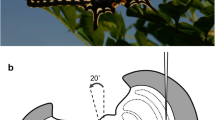Abstract
The spectral sensitivity of the dark-adapted eye of the snailHelix lucorum L. was investigated in semiintact “optic cupoptic nerve-cerebral ganglion” preparations. The data of the recording of the electroretinogram in response to monochromatic radiation of varied intensities were used to plot the spectral sensitivity functions. The averaged spectral sensitivity function is well described by a Dartnall nomogram for the photopigment rhodopsin with a sensitivity peak at 496 nm.
Similar content being viewed by others
References
R. Granit,The Electrophysiological Investigation of Reception [Russian translation], Izd. Inostr. Lit., Moscow (1957).
A. M. Chernorizov, E. D. Shekter, M. M. Zimachev, and E. N. Sokolov, “Helix lucorum L. vision. I. Studying of light and color sensation,” in:Simpler Nervous Systems. Abstracts of Regional Meeting of Intern. Soc. for Invertebrate Neurobiology [in Russian], Minsk (1991), p. 19.
H. J. Dartnall, “The interpretation of spectral sensitivity curves,”Br. Med. Bull.,9, No. 1, 24–30 (1953).
T. G. Ebrey and B. Honig, “New wavelength dependent visual pigment monograms,”Vision Res.,17, No. 1, 147–151 (1977).
J. L. Luborsky-Moore and J. W. Jacklet, “Aplysia eye: modulation by efferent optic nerve activity,”Brain Res.,115, 501–505 (1976).
K.-I. Naka and W. A. H., Rushton, “S-potentials from color units in the retina of fish (Cyprinidae),”J. Physiol.,165, No. 3, 536–555 (1966).
E. D. Shekter, M. M. Zimachev, G. G. Arakelov, and E. N. Sokolov, “Helix lucorum L. vision. III. Optical nerve activity and coding of light stimulus,” in:Simpler Nervous Systems. Abstracts of Regional Meeting of the Intern. Soc. for Invertebrate Neurobiology [in Russian], Minsk (1991), p. 85.
E. von Berg and G. Schneider, “The spectral sensitivity of the dark-adapted eye ofHelix pomatia L.”Vision Res.,12, No. 12, 2151–2152 (1972).
C. A. G. Wiersma and J. L. M. Roach, “Principles in the organization of invertebrate sensory systems,” in:Handbook of Physiology (The Nervous Systems I), Bethesda, Maryland (1977), pp. 1089–1135.
M. M. Zimachev, E. D. Shekter, G. G. Arakelov, and E. N. Sokolov, “Helix lucorum L. vision. II. ERG-studying of coding of light stimulus intensity,” in:Simpler Nervous Systems. Abstracts of Regional Meeting of Intern. Soc. for Invertebrate Neurobiology [in Russian], Minsk (1991), p. 117.
Author information
Authors and Affiliations
Additional information
Translated from Zhurnal Vysshei Nervnoi Deyate'nosti imeni I. P. Pavlova, Vol. 42, No. 6, pp. 1150–1155, November–December, 1992.
Rights and permissions
About this article
Cite this article
Chernorizov, A.M., Shekhter, E.D., Arakelov, G.G. et al. The vision of the snail: The spectral sensitivity of the dark-adapted eye. Neurosci Behav Physiol 24, 59–62 (1994). https://doi.org/10.1007/BF02355653
Received:
Revised:
Issue Date:
DOI: https://doi.org/10.1007/BF02355653



